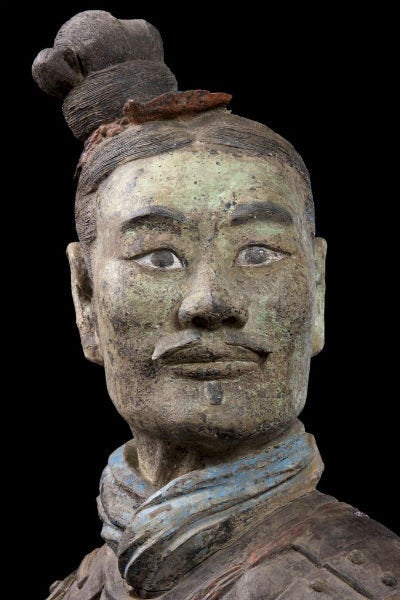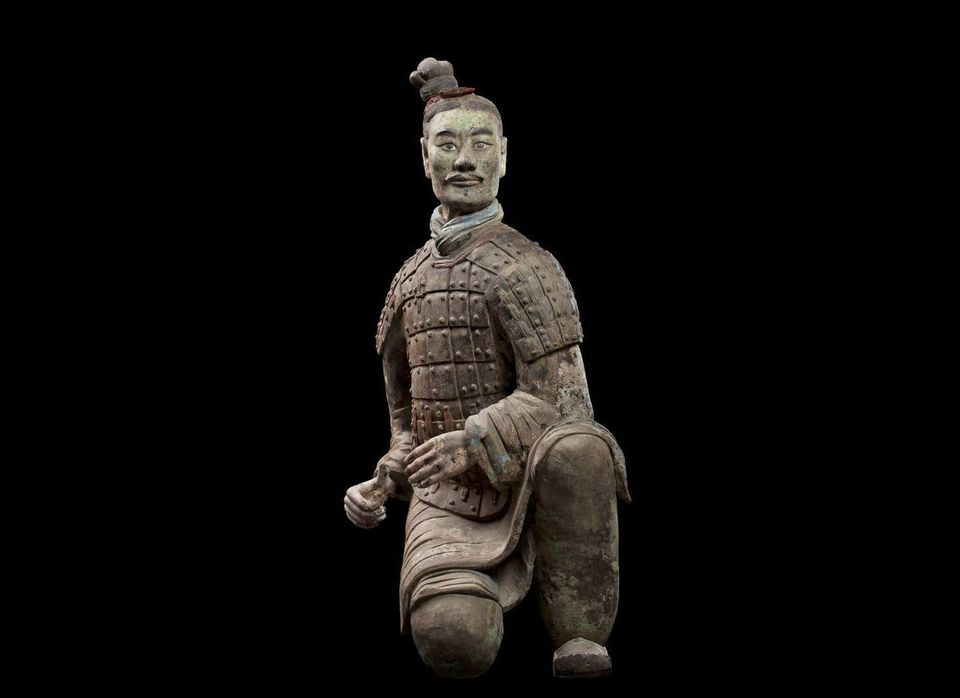

Armored kneeling archer (detail), Qin dynasty (221-206 BCE). China. Terracotta.
Excavated from Pit 2, Qin Shihuang tomb complex, 1977. Qin Shihuang
Terracotta Warriors and Horses Museum, Shaanxi.
It's hard not to give oneself over entirely to awe when regarding any of the great man-made wonders of the world. One wants to stare moist-eyed at these masterpieces and ponder the soaring ambition, ingenuity and perseverance of man, but there's always that moment when the docent or catalogue informs you of the horrific human cost of the endeavor: slaves crushed under limestone blocks and blinded architects and the like. With the introduction of the unwelcome historical factoid, uttered apologetically or printed small in the footnotes, what should be monuments to man's genius instead become ostentatious symbols of his cruelty.
On display through May 27th at San Francisco's Asian Art Museum is "China's Terracotta Warriors: The First Emperor's Legacy," featuring ten* of said warriors as well as 110 other objects from the burial sites surrounding First Emperor Qin Shihuang's tomb completed around 208 B.C.. Merging seven states into the first incarnation of a unified China, the First Emperor (whom I'll henceforth refer to by his name, Zheng, rather than his title) oversaw innovations in architecture, plumbing and irrigation, and the standardization of script, measurements and currency. He abolished the old hierarchical feudal system and instituted one of prefectures and counties answerable to and controlled by the central government -- which led to what should be but isn't one of the most infamous mass book-burnings in history.** He initiated construction on the Great Wall of China, which can be seen from space but still wasn't his most spectacular project. His chef d'oeuvre was his own underground burial complex, a 40-year vanity project the size of four football fields and for which he corralled over 700,00 workers and a vast amount of resources and wealth. This is not just a tomb -- his tomb is there, but has not been opened -- the complex includes a scale replica of his palace, stables (with bronze model and real, sacrificed horses), an armory, a zoo with more animals, rivers of Mercury modeled after the Yangtze and the Yellow rivers, entertainment parks with musicians and acrobats, additional burial pits and cemeteries, all rigged along the perimeter with auto-triggered crossbows and arrows to shoot potential graverobbers.

Charioteer, Qin dynasty (221-206 BCE). China. Terracotta. Excavated from Pit 1,
Qin Shihuang tomb complex, 1983. Qin Shihuang Terracotta Warriors and
Horses Museum, Shaanxi.
The most dazzling excavation from the site, and the focus of this exhibit, is the terracotta army, 8,000 in number, and each slightly larger than lifescale and individually featured. Not one looks like another, either in physiognomy, costume or even coiffure. They represent a one-off burst of realism in Chinese art, unprecedented and thereafter discontinued (at least until the modern era). The fact that the museum can only present ten of them is unfortunate; undoubtedly much of their power lies in their great number. Examining photographs from the site invites one to imagine what it would be like to stumble in upon this vast, silent and fearsome crowd; it really is an army, and even without their original coloring***, they are vividly lifelike. Whether standing with their weight seemingly centered on the balls of their feet, as if ready to sprint forward at any moment, or crouching with their (absent) arrows primed, there is a directness to their gaze that suggests their sculptors intended whoever beheld them to feel beheld by them as well. This makes sense, as the warriors had a more active purpose than simply to be admired; presumably anyone who made it past the rigged arrows and crossbows needed a good fright to deter them from the treasures within. Also, a king who believed immortality was achievable and that he had only to prepare for it, needed an armed guard in death as he did in life.
Compare the terracotta warriors to the Greco-Roman way of depicting soldiers: Polykleitos seemed more concerned with perfecting his figures' Contrapposto (probably one of the less effective battle postures) than with creating figures that would incite the same fear that a real soldier would. The Borghese Collection's "Fighting Warrior" stands with his legs splayed, his shield-bearing arm outstretched, his weapon-bearing arm preparing to riposte. It almost seems like he's posed this way as an excuse for a flattering in-the-round presentation of his beautiful thighs. The Greeks, and their Roman successors, had a complex purpose in depicting warriors, to convey not only the virtues of warriors themselves but the ideals of Man: proportionality, grace, the brave life, the noble death. One can be drawn into their experience, as one is to, say, that of Dying Gaul (a personification of the fallen region), with his pained brow and vanquished mien. The terracotta warriors possibly have a less lofty purpose, as a literal stand-in for the real thing. Despite their uniquely-fashioned visages, they do not invite one to consider them as people, to wonder about their experience and their non-military personae. Instead, staring out with illusory alertness, they project: "There's nothing to see here; turn around or get an arrow through the neck." They are possibly some of the most accurate depictions of warriors in art if one considers what a warrior's role is to the men and states that send him to war -- not a human being that experiences, but a machine that functions.

Armoured General (detail), Qin dynasty (221-206 BCE). China. Terracotta. Excavated from Pit 1, Qin Shihuang tomb complex, 1980. Qin Shihuang Terracotta Warriors and Horses Museum, Shaanxi.
After uprooting artisans and their families from all around his kingdom to work on his subterranean mausoleum, which, along with his other largescale construction projects, had already resulted in the deaths of untold numbers of laborers****, upon completion a couple of years after his death, Zheng had ordered that the remaining artisans and craftsmen involved be themselves buried alive within the complex.
Imagine that.
No, really -- imagine, for instance, you have finally completed the piece you've likely been working on all your adult life. Instead of slapping the dust off your hands and workpants, going for a stroll outside, updating your resume and planning the next project, you and all your fellow workers are shoved back inside the worksite and the gates slammed shut behind you, because the emperor doesn't want word getting out of all the amazing things you've hand-made for his tomb. Imagine stumbling around in the pits, trying desperately to find an exit that hasn't been sealed with molten copper. Imagine the stench of dead horses and human waste. Imagine being the last worker left standing, in the dark, dizzy from mercury fumes, as every last person you knew is dead from poisoning or starvation or a wayward auto-triggered arrow. Maybe some of the "man-fish" (possibly whale) oil lamps installed and intended to last for all eternity are still burning, so you can examine your friends' decomposing faces as you wait for your own solitary death.
Once again, the awe inspired by the most mystifyingly ambitious and splendid human achievements is accompanied by the moral gut-punch of how they came to be. How counterintuitive, that some of the most impressive of man's works have such a pat moral addendum, stuck like toilet paper to the bottom of their shoe. Qin Shihuang's burial complex, the pyramids, Venice, the discovery of the New World -- they make it seem like anything is possible as long as you don't care who you kill along the way, as long as a human being is just a machine to grind into the ground until your pièce de résistance is complete. China's First Emperor built (in the figurative sense, obviously) works that still beggar belief. Even without being able to witness the scale of his burial treasures, it might take several visits to appreciate what the Asian Art Museum does have on display. Yet even as one marvels at the size of his accomplishments, one suspects, with sinking heart, that, like so many of the world's marvels, they wouldn't exist at all or in such magnitude had their author's ambition and ruthlessness not dwarved his humanity.
*The maximum number allowed outside China in a single exhibition.
**By 213, courtiers and scholars had begun grumbling about the new system, with the scholars advocating shigu, or "learning from the past," as a model for governing. This would in effect return the old order, decentralizing the power Zheng had amassed, so at the suggestion of his Cheney-esque prime minister Li Si, Zheng ensured that minimal shigu would thenceforth be possible by ordering the burning of all books of literature and philosophy, but saved for posterity the books on medicine, forestry, divination and the history of his own family.
***The warriors were originally painted in brilliant hues using pigments made from malachite, azurite, cinnabar, charcoal, burnt bone and other materials.
****This is not including the hundreds of scholars and necromancers Zheng had executed because he was dissatisfied with their advice for achieving immortality or suspected them of treason.
